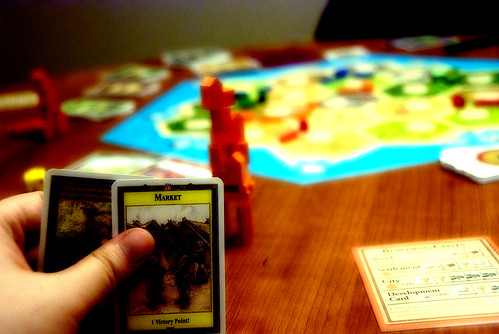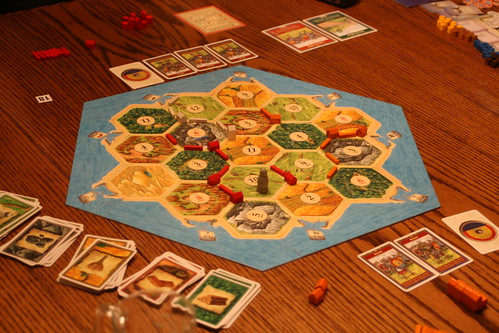Game Review: Settlers of Catan
Back at my student house in Delft, we used to play this game a lot. I never got around to getting the game myself, cause the rules said it was only for 3-4 players. We recently found out though that it is playable with 2 if you adapt some of the rules. It’s a great game and one of must-haves for a true boardgame geek.
Title: Settlers of Catan (Kolonisten van Catan)
Type: Boardgame
#Players: 3-4 (or 2 with adapted rules, 5-6 with extensions)
Cost: £20-25
Settlers of Catan is a played on a board of hexagonal tiles, that represent the island of Catan. At the start of the game the tiles are placed randomly or in a specific predetermined manner (but always with sea tiles surrounding it all). The island tiles represent the different resources: grain, wood, brick, ore and sheep (there aren’t any set names for the resources, we keep using other words like wheat, stone and clay too). Numbered tokens are then placed on each of the tiles, except for the resourceless “desert” tile.
The idea of Settlers is to build settlements and roads at the corners and on the edges of the hexes. Every player starts the game with two settlements and two adjoining road segments, and has to collect resources to be able to build more. You’re only allowed to build settlements at the end of one of your roads, and no two settlements may be built on adjacent corners. During each players turn, a roll of two dice determines which resources are allowed to be collected: every person with a settlement on the tiles with the number that was thrown is allowed to collect that resource. For instance, in the game in the picture above: if the number 5 is thrown, both the white player and the blue player may collect a brick, while the orange player is allowed to collect a grain.
During a players turn that player may spend their resource cards to build more. A brick and a wood builds a road. A brick, a wood, a sheep and a grain builds a settlement. And two grain and three ore builds a city. A city is an upgrade of a settlement, allowing a player to pick up double the resources for the adjacent tiles. Besides the building of the above, you can also use resources to buy a development card; these cards can do various useful things (I won’t explain all the different types of cards here).

The winner is the player who first reaches 10 victory points. You receive a victory point for each settlement you have on the board, and two victory points for every city you have (so no points for roads). Various other achievements, like building the longest road, can give you extra victory points.
The most interesting aspect of Settlers is the trading. Players are allowed to trade the resources they have in their hand, with other players or “off-island”. During your turn, you can initiate trades with any of the other players (if they are willing). This can be particularly handy if you’re not on a certain resource, while others are. With the “off-island” trade, you can exchange 4 of the same cards into any card you want (with the “bank”). Furthermore, there are special sea ports on the map that allow people with settlements on them better trading prices (like exchanging 2 sheep for anything you want).
As I said at the beginning of this post, Settlers of Catan is meant to be played with 3-4 people. From my own experiences 3 is the best number to play with. When you’re with 4 it’s still possible, but the map is slightly more full, leaving less space to maneuver. There are various adapted rules for 2 players floating around on the internet, and I’ve tried a couple of them. I’m still not completely happy with that game play though, and still trying to refine it.
Like Carcasonne, Settlers of Catan is a “friendly” game. All players are in play until the end of the game (unlike Risk) and there are no ways to destroy points from people. There are ways to annoy people though like by refusing to trade, cutting off road routes, taking the longest road (by creating a road longer) and using special development cards. The placement of your settlements at the start of game can be crucial to the rest of your game; you have to give yourself enough space to build more roads and settlements (without getting boxed in), while trying to receive the best possible resources.
Settlers of Catan is a fun board game, which requires logical thinking, smooth talking and scheming. There are a couple of different expansions available, but I haven’t tried them out yet. It’s a great way to spend a Sunday afternoon with a couple of friends, and (like I said before) a must-have for every boardgame geek.
Settlers of Catan is available for £29.99 at The Orc’s Nest (near Cambridge Circus), £33 on Amazon.co.uk, and $33 on Amazon.com.


